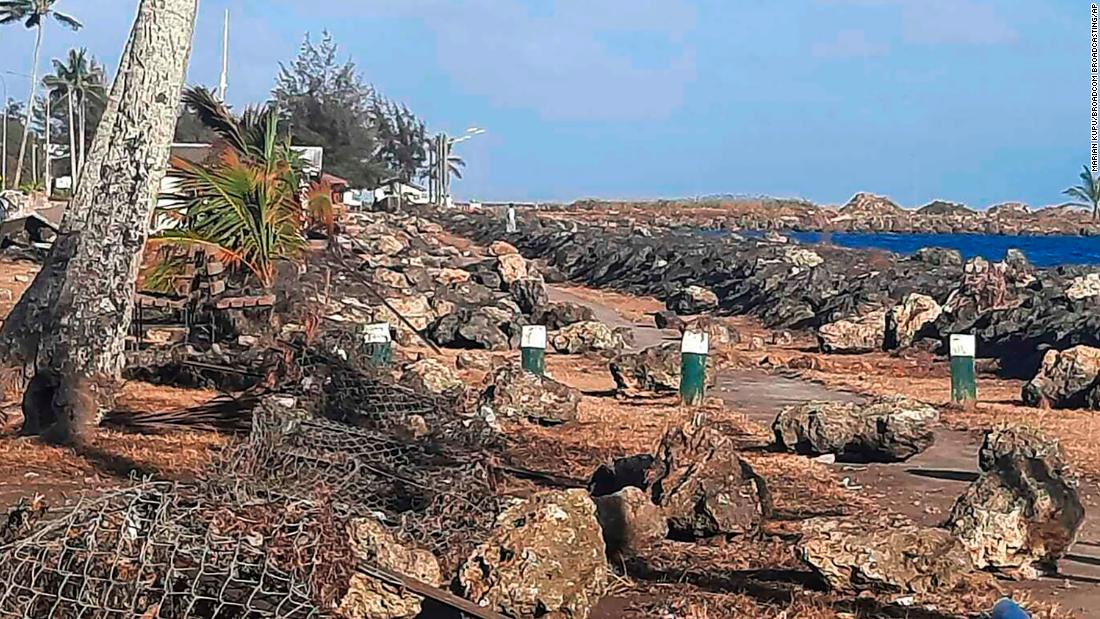A New Zealand Air Force C-130 Hercules aircraft carrying sanitation, water purification, shelter and hygiene kits along with generators and communications equipment, has arrived in Tonga, Wellington’s Foreign Ministry said in a statement Thursday.
It was expected to be on the ground for up to 90 minutes before returning to New Zealand, the statement added.
“There is going to be no contact. We have been rigorously disciplined in ensuring that Covid is not transmitted into Tonga,” New Zealand’s commander of Joint Forces, Rear Adm. Jim Gilmour, told reporters.
In addition, the offshore patrol vessel HMNZS Wellington is expected to arrive at the Nuku’alofa harbour on Thursday, ahead of other supply ships, according to a statement from the New Zealand government.
The ship is transporting hydrographic and dive personnel, and has a helicopter to assist with supply delivery, the statement said.
Another navy vessel carrying 250,000 liters of water will arrive in Tonga on Friday, Gilmour said.
The first of two C-17 Royal Australian Air Force planes has also landed in Tonga, according to Australia’s international development minister.
“Landed! [Australia]’s first RAAF flight carrying much needed humanitarian supplies has landed in Tonga, & a second C-17 is now on it’s way,” Minister Zed Seselja tweeted Thursday. “These flights will deliver shelter, hygiene kits, PPE for people clearing ash, water containers, & other supplies to support immediate needs.”
Meanwhile, another Australian Navy ship carrying aid will “soon” sail from Brisbane to Tonga, Australia’s Defense Department wrote on Twitter on Thursday.
“Tonga remains Covid-19 free and I reassured [Tongan] Prime Minister [Siaosi] Sovaleni that we are placing the highest priority on delivering Australia’s support in a COVID-safe way,” Australian Prime Minister Scott Morrison said in a statement Wednesday.
Australia has made an initial pledge of more than $700,000 toward Tonga’s recovery effort, Morrison added.
Japan’s Defense Ministry said Thursday it will also send two C-130 aircraft carrying drinking water to Tonga.
Tonga’s ‘unprecedented disaster’
At least three people died and many others were injured, the Tongan Prime Minister said.
All the houses on the island of Mango — where 36 people live — were destroyed, while only two houses remain on Fonoifua island, and extensive damage was reported on Nomuka island — home to 239 people, he added.
The island nation of more than 100,000 people was largely cut off from the rest of the world after a key underwater cable was damaged in the eruption. Some smaller islands are still offline, with officials and rescue workers racing to establish communication.
Photos showed entire island communities blanketed by a thick layer of gray ash, homes and buildings destroyed and coastal roads badly damaged.
The ash, coupled with stagnant water from the tsunami, contaminated water and food sources, according to the Red Cross.
The delivery of aid was hampered by ashfall covering the airport runway, forcing New Zealand to send two navy ships to assist with recovery on Tuesday.
Securing access to safe drinking water remains a critical priority for aid groups, who are concerned about the spread of diarrhea and diseases such as cholera.
The explosion of the Hunga Tonga-Hunga Ha’apai volcano sent shockwaves around the world and triggered tsunami waves that were felt thousands of kilometers away, killing at least two people in Peru.
The volcano sits on the seismically active Pacific Ring of Fire, and is about 65 kilometers (40 miles) north of Tonga’s capital.
On Tuesday, New Zealand’s Foreign Ministry warned further eruptions of the volcano were likely, posing a tsunami risk.
The estimation was based on modeling by GNS Science, a New Zealand geological research institute, the ministry said. “The most likely scenario is for ongoing eruptions in the next several days to weeks, with ongoing tsunami risk to Tonga and New Zealand,” it said.
CNN’s Angus Watson in Sydney, Caitlin McGee in Auckland, Eric Cheung, Lizzy Yee and Alex Stambaugh in Hong Kong contributed reporting
